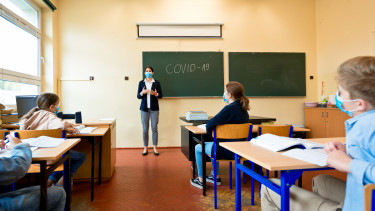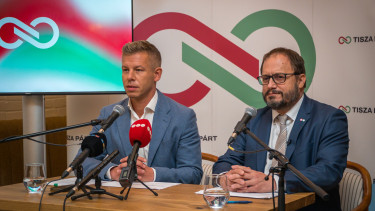Should schools re-open in Hungary next week?

The gist of this article is this:
- When the cabinet decided at the end of March that schools would re-open on 19 April, no one had a clue what the epidemiological situation would be by then, but there were strong indications that it would not show significant improvement.
- The trend has become clear by now, and all data show the situation is worse or at least as bad when the decision on re-opening was made.
- There are no reliable information on how children transmit the infection, how many of them are in hospital with COVID-19, or how Hungary is doing in terms of herd immunity (in reality, about a quarter or a third of the population at most could be protected via vaccination or infection).
- With schools re-opening, the pandemic will persist longer.
- The longer it stays with us, the more people, young and old alike, will be infected with coronavirus. More people will die, or recover but possibly have long-term consequences of the infection.
- Re-opening could cause less damage if as many parents as possible do not let their children back there.
- The cabinet could solve this situation if it delayed the re-opening or at least implement and enforce much stricter epidemiological rules in schools.
Schools as transmission hotspots
According to a guidelines written by scientists, physicians, parents, and educators, “it is not safe to reopen schools for in-person schooling while community transmission is still present. In-person schooling increases the risk of rapidly escalating case numbers throughout the community, placing health and lives at risk and possibly requiring further lockdowns to contain transmission. Before a community can safely begin to reopen schools (primary, secondary and higher education), they must bring new cases to zero and have safeguards in place to keep cases at zero.”
From the beginning of the COVID-19 outbreak, we were told that children were unlikely to catch or transmit the virus. However, as the virus has spread around the world, we have learned that children can get infected with the virus and can become severely sick with COVID-19. We have also learned that children can be infected as often as adults and can even have significantly higher levels of virus. With the emergence of the B.1.1.7 coronavirus variant (dubbed UK or Kent variant), which is more contagious and was thought to cause more severe illness and a higher risk of death (a theory countered by a recent study) it has become clear that SARS-CoV-2 poses a great threat not only to elderly people but young ones, even children too.
Global examples show that when there’s coronavirus infection in a school during a time when the virus is spreading in communities, it is generally not just members of a single class that need to be quarantined, but often the whole institution needs to be shut down.
Hungarian authorities publish no data on the number of children with coronavirus infection, or how many people under 18 years of age are/were in intensive care units and on ventilator. There are sporadic reports that about 100 children required mechanical ventilation since the outbreak and that a lot more children with COVID-19 need to be hospitalised in the third wave than previously. Global studies show that 3% of infected children need to be taken to hospital and one third of them end up in the ICU.
The third wave in Hungary
There is no research into where the pandemic is/was spreading the most violently in Hungary (schools, work places, stores), but it’s no question that schools became hotspots in the early stages of the second wave. An increasing number of schools switched to distance learning, as they were crippled by infections over a matter of days, as B.1.1.7 spreads at least 50% faster than the previous (Wuhan) strain. This means that by the time restrictions are put in place, widespread transmission makes in-class learning impossible for most classes.
Before the general closure of schools, 25% of the institutions were affected by infections. Closed classrooms and the high number of contacts, coupled with lax compliance with epidemiological rules makes protection against the virus virtually impossible, particularly if the protective measures are not stringent enough, anti-pandemic resources are scarce and the reaction time of authorities after the emergence of new cases is slow. The rapid spread of coronavirus forced the cabinet to close schools as of 8 March. The Operational Corps managed the disclosure of school-related epidemiological data with a high degree of laxity.

Re-opening linked to vaccination milestones
When the government decided in late March that schools would return to in-class learning on 19 April, not even the most well-informed virologists had accurate estimates how the pandemic situation will look like on or around that day. Under pressure by teacher organisations and possibly in consideration of incoming data, the cabinet decided last week to push back the re-opening of secondary schools by three weeks to 10 May.
Prime Minister Viktor Orbán has announced in a video posted on his Facebook page today that restaurants will be allowed to re-open their terraces once there are 3.5 million people vaccinated against COVID-19, and that only the 1st-4th grades of elementary schools will be re-opened on 19 April.
There are over 725,000 elementary school students in the 2020/2021 school year, according to preliminary data by the Central Statistical Office (KSH). Slightly less than half of them are in 1st-4th grade. That is still about 360,000 students. That's a lot of contacts and lot of chances to transmit and contract coronavirus both in school and at home.
Vaccination milestones
The government has decided to link the easing of lockdown measures to the ratio of the population vaccinated against SARS-CoV-2. The first such milestone was set to 2.5 million and once it was reached, the easing of curbs was announced. These included the re-opening of stores with longer opening hours, the shortening of the night curfew and the re-opening of nurseries and schools.
Prime Minister Viktor Orbán came up with the 2.5 million threshold on the conviction that this is the number that would mean everyone over the age of 65, i.e. the most at risk of dying of coronavirus-related diseases, was vaccinated.
The second milestone was set to 3 million but so far no official explanation has been provided as to why.
Orbán said on 2 April that those vaccinated would likely be granted preferential treatment in certain areas, but only when 3.5 million people have received their first shot. Another milestone we have no idea how he has come up with.
Prime Minister Viktor Orbán said that he hoped 3.5 million of Hungary's 10 million people would receive at least one coronavirus vaccine dose by 19 April, allowing curbs to be eased further. Elementary schools are still scheduled to re-open next Monday, while final oral exams for secondary school seniors (between 4-26 June) were scrapped.
In contrast, Orbán told state radio last Friday that 70% of the population could receive a vaccine shot by early June, allowing Euro 2020 fans "to have the possibility to attend the events with an immunity card." Budapest aims for full-house (i.e. 67,000 fans) football matches in the newly-built and exorbitantly expensive Puskás Arena in Euro 2021 (the European Football Championship). Budapest is scheduled to host three Group F matches on 15, 19, and 23 June, and a round of 16 match on 27 June.
Facing an election in 2022 and determined to avoid another year of recession, Orbán is opening up the economy after accelerating vaccinations, while global examples show that without a high enough stringency of lockdown measures vaccination does not help flatten the epidemic curve. The government denied any connection between the re-opening of the economy and Euro 2021.
Number of COVID-19 cases higher than when schools were closed
When B.1.1.7 emerged in schools in February and they were closed down one after another, Hungary reported 1,000 to 3,000 new confirmed COVID-19 cases per day. Now the rolling 7-day average is over 5,000. When schools were closed in early March, there were 6,000 COVID-19 patients in hospital, with 600 of them on ventilator. Now there are more than 10,000 in hospital, and over 1,200 require mechanical ventilation. The positivity rate is also higher now.

Consequently, and unsurprisingly the number of active cases is a lot higher than at the time of school closures therefore chances are much higher than virus carriers will be in school communities than before the closures.
The risks of infection are somewhat reduced by the fact that most teachers have been vaccinated. However, as they were sidelined by the cabinet for a long time and their vaccination have started only recently, they will not be or not fully protected by next Monday. That is one of the reasons teacher unions protest the re-opening. And children are still not vaccinated so…
With more active cases and a more contagious variant at play, there’s a much higher risk of community spreading than when schools were closed. The teachers, the children and their parents/relatives could be subjected to infection that could be avoided.
It is basically up to teachers (either individually or in a unified front) and parents to thwart this arguably unwise and risky move.
As a parent you have the right not to send your kid back to school. You and your children might need to face the music, but anything is better than not having to live with the consequences because you’re dead.
Where are you most exposed to infection? In schools!
Researchers at the Berlin Institute of Technology and at Hermann-Rietschel-Institut found that the risk of infection varies greatly depending on the type of enclosed spaces.
The chart below 1 shows different types of use/indoor environments. In each case, x-times the risk relative to a situational Rs-Wert ≤ 1 is given. The calculation of the Rs-value can be derived from. The Rs-value means the number of infected persons if an infected person is present at the same time. Even if the calculation of the Rs-values is not sufficiently evidence based, it does not play a role in the comparative evaluation. The shown bars would just be moved parallel to the left or right.

The safest indoor situation is to be in a theatre, the opera, or a museum at 30% occupancy, wearing a mask. In that case the R-value is 0.5, i.e. two infected people can infect another one on average. Surprisingly, going to the hairdresser and using public transport while wearing a mask are also among the activities that expose you the least to infection.
Shopping with mask in stores where the number of shoppers is maximised at 1 per every 10 square metre (the current regulation in Hungary) carries an R-value of 1.1, and it jumps to 1.5 in case of a sports hall at 50% occupancy without a mask.
The three worst are secondary schools at 50% occupancy without mask (R0=5.8), multi-person offices at 50% occupancy without mask (R0=8.0), and secondary school without mask at normal occupancy (R0=11.5).
These are already shocking findings but what about this one?
Even if only half of the students are present in a secondary school classroom and they all wear masks, the R-value is still as high as 2.9. Lose the masks and it goes up to 5.8.
We need to highlight that these values were calculated with certain duration of stays in the select indoor environments. Shopping in a supermarket was estimated at 60 minutes, a stay at the hairdresser to 120 minutes, a visit to a museum/theatre/opera at 120 minutes, working in an office to 8 hours and staying in secondary school to 6 hours.
To assess the risk of infection via aerosol particles in enclosed spaces, the inhaled dose is important. The dose depends on: (i) source strength (emission rate), (ii) breathing activity (source and receiver), (iii) aerosol concentration in the room, (iv) duration of stay in the room.
Students in elementary schools apply regulations much more loosely than secondary school students, i.e. they are most likely not to wear a mask in class.
Teachers fully protected can mitigate the risks, but most of them will not have built full protection by 19 April.
How could school re-opening be made safe?
The lack of reliable data on the size of the protected population, the vaccination of teachers, and epidemiological statistics and trends strongly indicate that the re-opening schools on 19 April is not safe for teachers, children and anyone they meet. It would be a lot safer if a much higher percentage of the population was inoculated against COVID-19 and/or if epidemiological data were of a lot better quality. A couple more weeks without easing restrictions could have probably brought results in the latter, and in-class learning could have returned to safe waters after the final written exams in May.
What measures would be needed to make re-opening safe then?
- Free-of-charge weekly testing of every student and teacher, just like elsewhere in Western Europe. Immediate quarantine for positive cases and their contacts.
- Free-of-charge masks for every student and teacher.
- Remote learning for students that choose to stay home, regardless of how many classes they have missed so far, i.e. learning from home must not be registered as absence.
- Safe distance between seats in classes.
- Contact tracing as soon as anyone in class is suspicious of coronavirus infection, switching to remote learning until test results come back. Transmission in class and school would continue if the others continue to attend if the test comes back positive.
- Immediate and comprehensive testing of entire school when positive case(s) found.
- Mandatory mask-wearing on school property for students, teachers, staff at all times, except during lunch break but even then safe distance must be ensured and only a fraction of the canteen must be used.
- Cancellation of music classes. Singing and use of wind instruments increase risks of transmission. No classes where masks would need to be taken off.
As you can see, re-opening schools safely would demand massive efforts and capacities. Without these measures, however, the reduction in the number of new cases and everything that comes with it cannot be ensured. Quite the contrary. And that would result in more patients in hospital in the already strained health care system. And the more patients doctors and nurses have to take care of at once, the worse their chances of survival become.
The cabinet may share details of its school re-opening plans today. Hungary is listed among the countries that need to take action to beat COVID-19, and where re-opening is not recommended, as “re-opening too early runs the risk of triggering exponential growth again. This might erase all of the benefits gained from the lockdown so far. It could increase the total amount of deaths, overwhelm the medical system, and create a scenario where another lockdown is necessary.”
Experts have also repeatedly warned against re-opening schools prematurely.
Conclusion
It seems certain that the re-opening of schools will lead to a rise in the number of new cases, not necessarily a dramatic surge, but still. However, maintaining distance learning does not carry such a risk. And honestly, this school year is already ‘done for’. Why not just let it go? And what’s at stake here? Grades? Really? Who cares? It’s about lives, people. Yours, your kids’, your parents’ lives. Yes, there are other considerations too, as the government has also admitted. There’s economic and political aspects too. With Viktor Orbán focused on next year’s election he cannot really afford to become less popular, and people are indeed fed up with the lockdown, so in this sense he just does what his electors want. But sending back kids to school for a couple of weeks… is it worth it?
Cover photo: Getty Images









